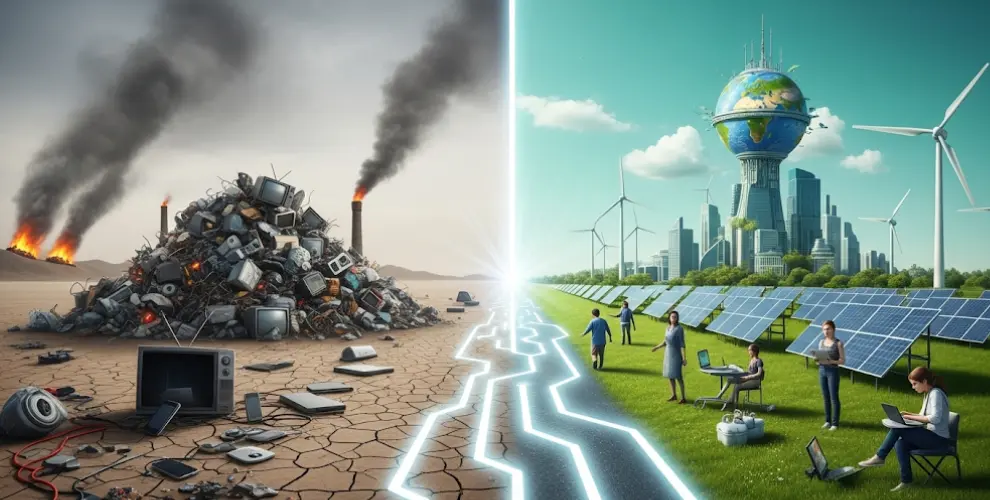
E-Waste Crisis & How Sustainable Tech Can Solve It
Table of Contents
Introduction
Welcome to WikiGlitz!
We’ve brought you this insightful blog to shed light on the growing e-waste crisis and how sustainable technology solutions are becoming vital in addressing it.
From rising landfills of discarded electronics to innovative green alternatives, this guide covers the root problem, key solutions, and how you can make a difference as a conscious consumer or business.
Key Takeaways
- Learn how green technology and circular electronics can help in reducing e-waste globally.
- Discover the importance of repairable electronics and electronic waste recycling in building a sustainable digital future.
- Understand how eco friendly gadgets and policy changes can mitigate the impact of the e-waste crisis.
What is the e-waste crisis, and why is it becoming a major issue in developed countries?
The e-waste crisis refers to the overwhelming amount of discarded electronic devices. Smartphones, laptops, TVs, and more—that end up in landfills or are improperly recycled.
Due to fast-paced technological innovation and shorter device lifespans, developed countries produce millions of tons of e-waste each year.
According to the Global E-waste Monitor, over 53 million metric tons of e-waste were generated globally in 2019, and that number is expected to rise steadily.
Developed countries generate the highest amount of e-waste, but frequently ship it to developing nations for disposal, raising serious ethical and environmental issues.
How does electronic waste recycling help the environment and economy?
Recycling electronic waste plays a crucial role in addressing the e-waste crisis effectively. When electronics are recycled properly, valuable raw materials like gold, copper, and rare earth metals are recovered and reused, reducing the demand for new mining.
Environmental benefits include:
- Lower greenhouse gas emissions
- Less contamination of soil and water
- Conservation of non-renewable resources
Economically, electronic waste recycling creates green jobs and contributes to a circular economy. It also lowers the environmental impact of producing electronics, benefiting both businesses and the planet.
How does green technology help in solving the e-waste problem?
Green technology includes sustainable manufacturing, renewable energy-powered production, and biodegradable materials used in electronics. This shift not only supports energy efficiency but also reduces harmful byproducts throughout the product lifecycle.
Key examples of green technology in action:
- Solar-powered devices that reduce energy dependence
- Biodegradable phone cases made from cornstarch
- Low-energy chipsets in smart appliances
By integrating green technology, companies in the US, UK, and across Europe are building products that are not just smarter—but cleaner.
What are circular electronics, and why are they important?
Circular electronics are devices designed to be reused, refurbished, and recycled at the end of their lifecycle. Unlike the traditional take-make-dispose approach, circular models focus on eliminating waste by continuously reusing products and materials throughout their lifecycle.
This approach includes:
- Modular device design (e.g., phones with replaceable batteries)
- Manufacturer-led take-back programs
- Partnerships with certified recyclers
Adopting circular electronics significantly aids in reducing e-waste while aligning businesses with growing regulatory frameworks in places like the EU and California.
How can eco-friendly gadgets reduce environmental impact?
Eco-friendly gadgets are built to support sustainability by using non-toxic materials, consuming less energy, and coming in recyclable or biodegradable packaging.
Examples include:
- Energy Star-certified laptops and monitors
- Bamboo keyboards and mouse devices
- Solar-powered chargers
For consumers, choosing eco friendly gadgets is a simple but impactful step in curbing the e-waste crisis. Brands like Fairphone, Framework, and Dell are leading the charge in sustainable consumer electronics.
What are the best sustainable technology solutions for businesses and governments?
To solve the e-waste problem at scale, both public and private sectors must implement strategic sustainable technology solutions:
For Businesses:
- Use enterprise-grade equipment with longer lifespans
- Partner with certified recyclers
- Provide incentives for product trade-ins
For Governments:
- Enforce extended producer responsibility (EPR) laws
- Subsidize R&D in green technology
- Launch consumer awareness campaigns
These sustainable technology solutions ensure that the responsibility of reducing e-waste doesn’t just fall on the consumer but becomes an ecosystem-wide mission.
How can individuals help in reducing e-waste at home?
Everyday users have a major role in reducing e-waste through conscious buying and disposal habits:
- Repair instead of replace: Choose repairable electronics over sealed units that cannot be fixed.
- Recycle responsibly: Use certified electronic waste recycling centers.
- Buy sustainably: Prioritize eco-friendly gadgets and modular devices.
Apps and platforms now make it easier to track, trade, or repair your electronics locally—empowering you to be part of the sustainable technology movement.
Why are repairable electronics the future of sustainable devices?
Repairable electronics are designed to be fixed easily without specialized tools or expertise. With laws like the Right to Repair gaining traction in the US and Europe, manufacturers are being urged to make their devices more accessible for repair.
Benefits include:
- Extended device lifespans
- Lower cost of ownership
- Reduced demand for raw materials
Major brands like Apple and Microsoft are already making moves toward more repairable electronics, which is a crucial shift in resolving the e-waste crisis long-term.
Which international policies are influencing the future of e waste management?
Several international initiatives are driving change:
- The EU’s Circular Economy Action Plan mandates that devices be designed with repairability in mind.
- The US Right to Repair bills are empowering consumers to fix their own gadgets.
- The Basel Convention regulates electronic waste recycling exports to protect developing countries.
As these policies evolve, companies must adopt sustainable technology solutions to stay compliant and competitive.
Conclusion
At the end, we hope this blog helped you understand the gravity of the e-waste crisis and how innovations in sustainable technology can lead us toward a cleaner, greener future.
No matter if you’re a consumer, business owner, or policymaker — the decisions you make have a real impact.
From embracing repairable electronics to investing in green technology, we all have a role to play in reducing e-waste and protecting our planet.
Follow WikiGlitz for more such insights into future-forward technologies that make the world a better place.
Frequently Asked Questions (FAQs)
1. What exactly is e-waste, and why is it a problem?
e-waste refers to discarded electronic devices like phones, laptops, TVs, and appliances. It becomes a problem when improperly disposed of, as it contains toxic materials that harm the environment and waste valuable resources that could be recycled.
2. How does electronic waste recycling work?
electronic waste recycling involves collecting, dismantling, and processing old electronics to recover useful materials like copper, gold, and plastic. This process helps conserve natural resources, reduce pollution, and support a circular economy.
3. What are some examples of sustainable technology solutions for managing e-waste?
Examples include green technology used in energy-efficient devices, repairable electronics that extend product life, and circular electronics designed to be reused or recycled instead of discarded.
4. How can consumers help in reducing e-waste at home?
Consumers can reduce e-waste by choosing eco friendly gadgets, repairing instead of replacing devices, buying products with longer lifespans, and properly recycling old electronics through certified centers.
5. Why are repairable electronics important for the environment?
Repairable electronics reduce the need to frequently buy new products, lowering the overall production and disposal of devices. This approach helps in reducing e waste, saving resources, and promoting long-term sustainability.





